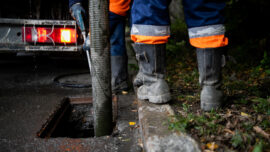Moling and Trenchless Moling
Here at Watermains and Drains, we understand more than anyone how important it is for you to get general maintenance done with as little hassle as possible. That is why we have our own moling equipment which makes it easier than ever for us to install a new watermain without having to excavate your lawn or your driveway. If you want to find out more about trenchless moling, and moling in general, then take a look below.
What is Moling and Trenchless Moling?
Moling, and trenchless moling is a technique that is used to lay down pipes without having to worry about building trenches. It is a very efficient method of installing pipes and you won’t have to worry about your garden being dug up either. Moling is one of the least invasive installation techniques out there and our team have the ability to bore under lawns, driveways, obstacles and more. If you want to find out more about moling or our service, then simply take a look below.
What are the Benefits of Moling?
Some of the benefits of moling include the fact that it is environmentally friendly. It requires minimal excavation, and it doesn’t cause any disruption either. It provides minimal disruption and barely any road closures. Moling reduces the amount of time that it takes to install water pipes and it also saves a considerable amount of time, not to mention that it is a brilliant way to reduce human resources too.
How does Moling Work?
During the process, we will use a machine known as a mole. This will force its way through the soil. To start the process, we will dig a hole that is around 2 metres deep. A hole this deep can be dug without the use of machinery. We will then dig a destination hole, and this is where the mole will come out of the other side. So why is a moling machine named as such? The mole itself was named after the activities of a mole, as they burrow into the soil. Pulsing, compressed air causes the mole to hammer against the soil, digging a tunnel. When the mole has passed the designated route, the pipe can then be pulled, right through to the destination.
Ensuring a Successful Completion
To ensure that the moling is completed successfully, we will first make sure that you have an appropriate soil type. We are very experienced when it comes to moling and we know that the soil type can have a huge impact on whether or not the moling process goes well. This is why we will always assess the soil first before moving ahead with the process.
If you want to find out more about our moling process or if you want to see how we can help you then please get in touch today. We would love to help you and we can also give you a free quote for any of our moling services too. We can’t wait to hear from you.




